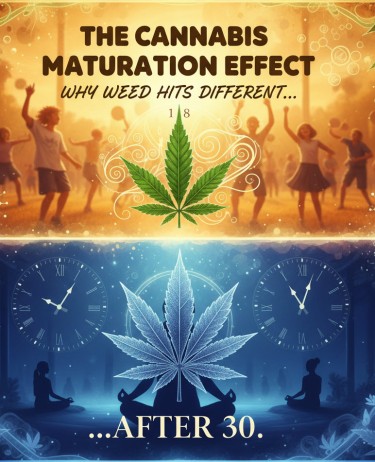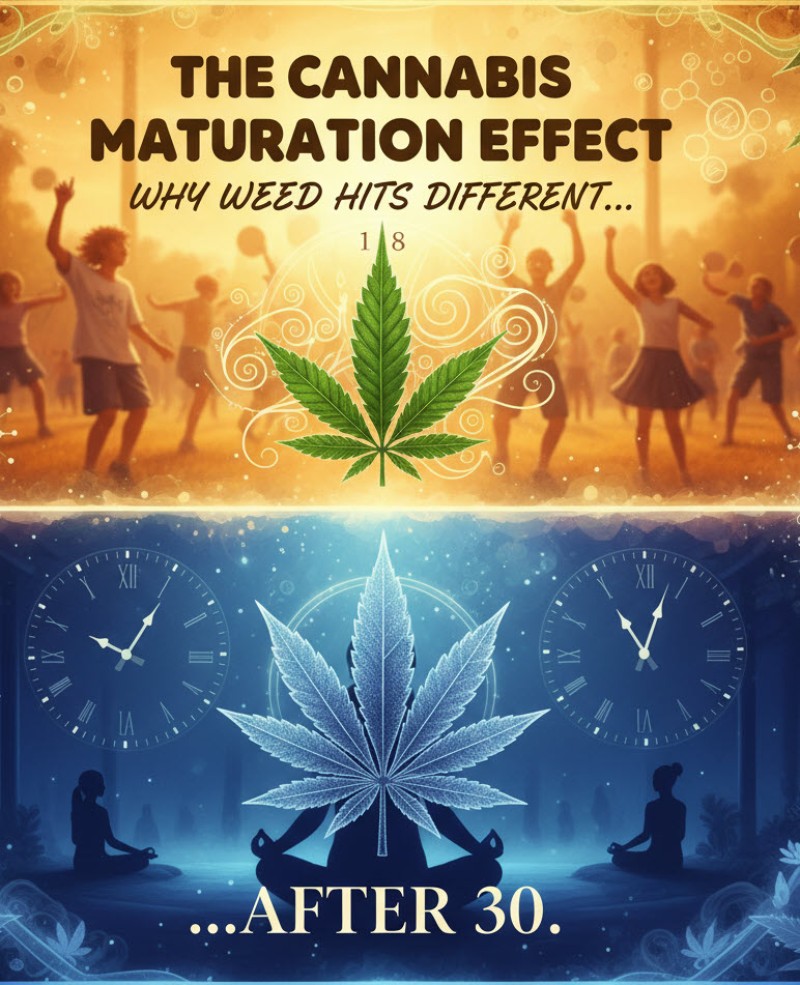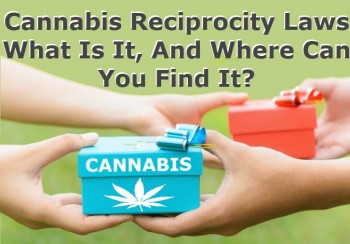
I remember my mid-teens with cannabis: everything was hilarious, conversations became sprawling philosophical explorations that went nowhere but felt profound, and music didn't just sound good—it became a transcendent experience that demanded I explain its brilliance to anyone within earshot. I'd get high and want to do things: go to concerts, explore the city at 2 AM, have deep talks about the nature of reality while eating an entire pizza.
Now? I'm in my forties, and cannabis is a completely different experience. I still enjoy it immensely, perhaps more than ever, but the effects have fundamentally changed. Where I once became social and animated, I now become introspective and calm. Where I once sought stimulation and activity, I now crave contemplation and stillness. The giggly, talkative high of my youth has evolved into something more measured, more thoughtful, and somehow more valuable.
I've noticed this pattern consistently among longtime cannabis users, and a recent Reddit thread confirmed I'm not alone. The question posed was simple: "Anyone else feel like weed hits different as you get older?" The responses overwhelmed the thread—hundreds of people describing the exact same phenomenon. Used to get giggly and social, now more chill and contemplative. Used to seek adventure, now seek reflection. Used to be about external experiences, now about internal exploration.
This isn't tolerance alone, though that plays a role. It's not strain selection, though that matters too. Something fundamental shifts in how cannabis affects us as we age, and understanding why reveals fascinating insights about brain development, the endocannabinoid system, and what cannabis actually does to our consciousness.
The shift from recreational stimulation to contemplative calm isn't a loss—it's a transformation. Young cannabis users are experiencing one aspect of the plant's effects, optimized for their developmental stage and life circumstances. Older users are accessing different aspects, equally valid and arguably more therapeutically valuable. The plant hasn't changed. We have. And that change opens doors to cannabis experiences that younger users literally cannot access because their brains haven't developed the capacity yet.
This article explores why cannabis hits different as we age, what's happening neurologically and psychologically to create this shift, and why the contemplative, thoughtful high might actually be the more profound experience. Because here's the truth that took me years to understand: cannabis doesn't just affect you differently as you age. It gets better. You just have to learn to appreciate what "better" means when you're not twenty-two anymore.
The Neuroscience of Changing Highs: Your Brain on Decades
Let's start with the hard science, because understanding the mechanism makes the experience make sense. The endocannabinoid system—the network of receptors throughout your body that cannabis interacts with—undergoes dramatic changes throughout your lifespan.
During your formative years, roughly until age 25, your body produces an abundance of endocannabinoids. This overproduction serves a crucial developmental purpose: it's building and fine-tuning your endocannabinoid system. Your brain is establishing neural pathways, pruning unnecessary connections, and optimizing its regulatory systems. The high endocannabinoid receptor density during this period is why young cannabis users often experience incredibly intense highs.
Those teenage and early-twenties cannabis experiences—where you're completely immersed in the high, where everything feels overwhelmingly potent—aren't just about low tolerance. Your endocannabinoid system is hypersensitive during this period because it's actively developing. You have more receptors, more natural endocannabinoids interacting with them, and introducing external cannabinoids creates effects that are genuinely more intense than what older users experience with the same dose.
As you mature past 25, natural endocannabinoid production decreases significantly. Your endocannabinoid system has finished its primary developmental work and enters maintenance mode. You have fewer endocannabinoids circulating naturally, and receptor density in certain brain regions decreases. This is completely normal—it's not system failure, it's system maturation.
This explains why many longtime users report that highs feel "different" rather than simply "weaker" as they age. It's not that cannabis becomes less effective; it's that you're interacting with a different endocannabinoid baseline. The cannabis you consume is supplementing a depleted system rather than amplifying an already abundant one.
Here's where it gets interesting: as we age, particularly when facing chronic stress, injuries, or health challenges, the endocannabinoid system can become even more depleted. This depletion contributes to various age-related issues—chronic pain, inflammation, sleep disturbances, mood regulation problems. Many older adults who try cannabis for the first time in their 60s or 70s report remarkable benefits precisely because they're revitalizing a severely depleted endocannabinoid system.
But beyond receptor changes, your actual brain structure evolves. The prefrontal cortex—responsible for executive function, decision-making, and emotional regulation—continues developing into your mid-twenties. Once fully developed, it provides more cognitive control over your experiences, including your cannabis high. You're literally better equipped to direct and shape your altered state than you were at 20.
The brain's default mode network, which governs self-referential thinking and mind-wandering, also changes with age and experience. Cannabis affects this network significantly, and how it affects you depends partly on how that network has been shaped by decades of life experience. A 40-year-old and a 20-year-old consuming identical cannabis are working with fundamentally different neural architecture.
Tolerance obviously plays a role, but it's more nuanced than simple receptor downregulation. Long-term cannabis users develop what researchers call "behavioral tolerance"—you learn to function while high. Your brain creates compensatory mechanisms that allow you to perform tasks despite cannabis's effects. This is why studies show that regular users demonstrate far less impairment on cognitive tests after consuming cannabis compared to occasional users receiving the same dose.
But there's also something called "reverse tolerance" in longtime users, where certain effects actually become more pronounced or accessible with experience. This isn't about receptors becoming more sensitive; it's about your brain learning to recognize and utilize specific cannabis effects that you didn't notice or couldn't access as a novice user. The contemplative, introspective high that many older users describe might fall into this category—an effect that requires cannabis experience and life experience to fully manifest.
Your neurotransmitter systems also change with age. Dopamine receptor density decreases. Serotonin system function shifts. GABA and glutamate balance evolves. Cannabis interacts with all these systems, and how it interacts depends on your baseline neurotransmitter profile, which changes throughout your life. The giggly, euphoric high of youth might be partially explained by higher baseline dopamine receptor density that cannabis then amplifies. As that density naturally decreases, cannabis produces different subjective effects.
The psychological dimension cannot be separated from the neurological. Your first cannabis experiences occur in a context of novelty—everything is new, surprising, and overwhelming. By your hundredth or thousandth cannabis experience, novelty has evaporated. You know what to expect. Your brain isn't flooded with surprise-related neurotransmitters. The high becomes familiar territory you navigate with expertise rather than bewildering altered territory you stumble through.
Life experience itself changes how you interpret and utilize altered states. A 22-year-old getting high has accumulated perhaps a decade of substantial life memories and experiences to draw upon. A 40-year-old has accumulated three decades, including career development, relationships, losses, achievements, and the accumulated wisdom that comes from simply having lived longer. When cannabis facilitates introspection—which it absolutely does—you're introspecting on a much richer dataset at 40 than at 22.
The Contemplative Turn: Why Thoughtful Beats Giggly
Let's address the elephant in the room: many older cannabis users describe their changed relationship with the plant with a hint of nostalgia, as if they've lost something. The wild, giggly, adventurous high of youth feels gone, replaced by something calmer and more contemplative. There's an unspoken question: Is the new high worse?
No. It's different, and in many ways, it's better. But "better" requires redefining what you value from cannabis.
The giggly, social, energetic high of youth serves a specific purpose. It facilitates bonding, encourages exploration, makes mundane experiences feel novel and exciting. For young adults establishing independence, forming social connections, and exploring the world, this type of high is genuinely valuable. Cannabis as a social lubricant and adventure enhancer makes sense when your primary developmental task is expanding your social and experiential horizons.
But that's not where you are at 35 or 45. Your social circles are established. You've accumulated experiences. You don't need cannabis to make eating pizza at 3 AM feel like a profound adventure—you've done that, it was fun, and you're past it. What you need now is different: perspective, stress relief, pain management, enhanced appreciation for subtle experiences, and access to contemplative states that daily life doesn't afford.
The contemplative high delivers this. Instead of making you want to go out and do things, it makes you want to sit with yourself and process things. Instead of amplifying external stimuli, it quiets external noise and amplifies internal awareness. Instead of fragmenting your attention across multiple exciting inputs, it focuses your attention on singular experiences or thoughts with unusual clarity.
This is neuroplasticity in action—cannabis's ability to temporarily reorganize neural connections. In younger users, this often manifests as novelty enhancement and sensory amplification. In older users with more developed prefrontal cortex function and richer internal landscapes to explore, neuroplasticity facilitates what can only be described as psychological integration work.
Many therapeutic applications of cannabis depend on this contemplative state. PTSD treatment works partly because cannabis-induced neuroplasticity allows trauma survivors to revisit painful memories from new perspectives, potentially interrupting the negative feedback loops that perpetuate suffering. Depression treatment benefits from cannabis's ability to temporarily shift rigid thought patterns and allow new neural pathways to form. Anxiety reduction comes partly from cannabis's capacity to interrupt rumination and create psychological distance from stressors.
These therapeutic effects aren't separate from the recreational effects—they're the same effects experienced in different contexts. The contemplative high that makes you want to sit quietly and think is the same state that allows therapeutic psychological work. You're not losing the fun high; you're gaining access to a therapeutic high that requires neural and psychological maturity to fully appreciate.
Consider what you actually do during a contemplative cannabis experience. You might sit outside and genuinely appreciate the sunset in a way you don't when sober and distracted. You might listen to music and hear layers you've never noticed before. You might think through a problem at work and arrive at solutions your sober mind couldn't access. You might simply feel calm and present in a way that eludes you in daily life.
These aren't diminished experiences compared to laughing uncontrollably at a mediocre comedy special. They're different experiences that serve different needs. And honestly? The ability to consistently access calm, focused, contemplative states is more valuable at 40 than the ability to find everything hilarious was at 20.
There's also a self-selection factor. People who continue using cannabis into middle age tend to be those who found value in it beyond youthful recreation. They discovered that cannabis offers something sustainable—stress relief, pain management, creative enhancement, spiritual exploration—that remains valuable as life circumstances change. The people for whom cannabis was only about getting wasted and giggling probably stopped using it years ago, or only partake occasionally at parties. The ones still using it regularly have evolved their relationship with the plant to match their evolving needs.
This evolution often includes becoming more intentional about cannabis use. Young users often consume cannabis socially, reactively, whenever it's available. Older users tend to be more deliberate: specific times, specific settings, specific purposes. You're not just getting high; you're using cannabis for something. That intentionality changes the experience itself, creating a more focused and meaningful high.
The strains and products you choose matter too. As you develop cannabis literacy over years of use, you learn which chemotypes produce which effects for your specific neurochemistry. You move beyond "indica vs sativa" to understanding terpene profiles, cannabinoid ratios, and how different products interact with your system. This expertise allows you to curate your experiences with precision that novice users cannot access.
Many older users also report appreciating CBD-rich products more than they did in youth. Balanced THC:CBD ratios, or even CBD-dominant products, provide therapeutic benefits without overwhelming intoxication. This isn't about tolerating weaker effects—it's about recognizing that therapeutic efficacy doesn't require maximum psychoactivity. The clear-headed, calm focus that CBD provides becomes more valuable than the intense high that pure THC delivers.
The Sticky Bottom Line: Cannabis Maturity is Real
The phenomenon of cannabis hitting differently as you age isn't a bug—it's a feature. Your changing relationship with cannabis reflects your changing brain, changing life circumstances, and changing needs. The giggly, social, adventurous high of youth served its purpose. The contemplative, introspective, therapeutic high of middle age serves a different purpose.
Both are valid. Both are valuable. But only one is accessible to you right now, and learning to appreciate it rather than mourning what came before is part of cannabis maturity.
I've learned to love the contemplative high. When I consume cannabis now, I'm not looking for stimulation—I'm looking for calm. I'm not seeking external adventure—I'm exploring internal landscape. I'm not trying to enhance parties—I'm trying to enhance solitude. And cannabis delivers on all these goals more effectively now than it did when I was 25, precisely because my brain and life have evolved to a place where I can fully utilize these effects.
The key is adjusting your expectations and usage patterns to match your current needs. Stop trying to recreate the high of your twenties. That high was perfect for your twenties. Embrace the high that's perfect for right now: measured, thoughtful, therapeutic, and sustainable.
Choose your products intentionally. If you want contemplation, choose chemotypes that facilitate it—often higher CBD ratios, myrcene-rich terpene profiles, moderate THC rather than maximum THC. If you want to maintain functionality while experiencing relief, microdose throughout the day rather than getting maximally high in the evening. If you want creative insights, pair cannabis with activities that encourage them—writing, art, music, nature walks—rather than passive consumption.
Create set and setting that supports the experiences you're seeking. The contemplative high works best in contemplative environments: quiet spaces, comfortable seating, minimal distractions, perhaps some ambient music or nature sounds. Don't try to force the social, party high if that's not what your brain wants to produce anymore. Lean into what comes naturally.
Most importantly, recognize that this evolution is a gift. You're not losing cannabis's effects; you're gaining access to different effects that require neural maturity to appreciate. The plant is revealing new dimensions of itself to you because you've developed the capacity to perceive them. This is cannabis maturity, and it's something to celebrate rather than regret.
For those just beginning to notice this shift—usually late twenties to mid-thirties—you're not alone, you're not broken, and you haven't ruined cannabis for yourself through overuse. You're simply entering a new phase of your relationship with this plant. Embrace it. Explore it. And discover what cannabis becomes when you're old enough to truly appreciate its full complexity.
The giggles were great. But the wisdom is better.






